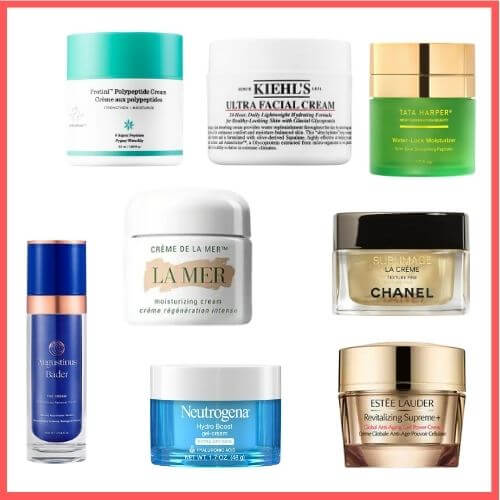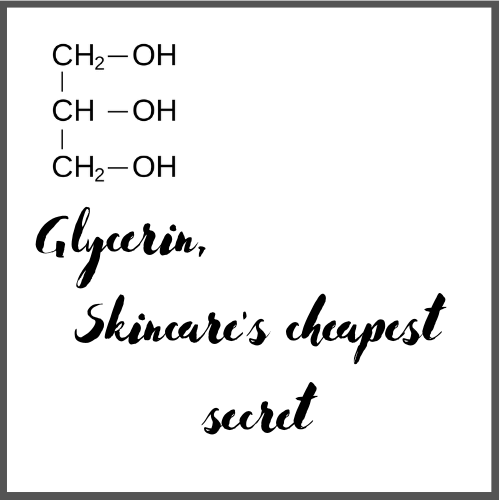It fascinates me that once you change your perspective, the same things appear very different.
For example, if you are a regular reader of this blog, I talk endlessly about Stratum Corneum being a barrier to prevent transepidermal water loss (TEWL). It does this through natural moisturising factors (NMF) in corneocytes and the lamellar lipid matrix. In addition, water-transporting proteins, hyaluronic acid, the corneo-epidermal junction, skin pH are all responsible for SC hydration.
This is not an exhaustive list.
It would be remiss of me if I didn’t mention Glycerin in the same vain. If you take one thing away from today’s blog, let it be this: topically applied glycerin restores Stratum Corneum hydration. Endogenous glycerin (ie, glycerin already in the skin) is essential to maintaining skin hydration. Finally, Glycerin costs as little as $6 per kg and therefore is cheap as chips. It is also present in a multitude of cleansers, moisturizers and soaps.
Here are just a few examples:

Q1) What is Glycerin?
Glycerin or Glycerol is a polyol with 3 hydroxy groups. In plain English, this means its highly hygroscopic and it’s a strong humectant (much like NMF in corneocytes) and bonds with water, giving it a large structure compared to its molecular weight. Of course, its not in the same league as Hyaluronic Acid in terms of volume (see Hyaluronic Acid part 1 and part 2).
Q2) Is Glycerin present in the skin?
Yes, endogenous glycerol is present in the skin. It can be transported into the stratum corneum by water-transporting proteins (aquaporins) who deliver it to basal cells.
Also, glycerol comes from the breakdown of sebum. In mice that had defective sebum production mechanism, its been demonstrated by Fluhr et al that a mixture of sebum like lipids did not restore normal stratum corneum hydration. The same was true about urea (another humectant present in the skin). However, the application of topical glycerol normalized stratum corneum hydration.
Q3) What is the role of glycerol in the skin?
Glycerol has been implicated in stratum corneum hydration. In mice that do not produce sebum (aespia mice), topical use of glycerol restores stratum corneum hydration.
Glycerin has been reported to stimulate the recovery of the skin barrier damaged by repetitive washing with surfactants such as sodium lauryl sulfate. (Atrux-Tallau N et al)
In addition, glycerol is essential to maintaining liquid crystallinity of intracellular lipids
Finally, its also important to regular desquamation of corneocytes in the skin.
Q4) How does glycerin hydrate the skin?
Baumman writes, “App et al compared 2 high glycerin moisturizers to 16 other popular moisturizers in 394 patients with severely dry skin. The high glycerin products were superior to all other products tested over this five year period because they rapidly restored dry skin to normal hydration levels. They also helped prevent the return to dryness for a long period than the other formulations, even those containing petroluatum.
Glycerin causes an expansion of the stratum corneum because of increased thickness of the corneocytes and expanded spaces between layers and corneocytes. These findings suggest that glycerin appears to create a reservoir of moisturing holding ability that renders the skin more resistant to drying.”
Q5) Topical application of glycerol?
Glycerol (and urea) are both staples of treating dry skin (atopic dermatitis). Topically applied glycerin does increase stratum corneum hydration.
Q6) Does the % of glycerin matter?
I think it does. Watch this space, while I try and find the answer to that.
Sources and uses
Choi EH, Man MQ, Wang F, et al. Is endogenous glycerol a determinant of stratum corneum hydration in humans? J Invest Dermatol. 2005;125:288.
Orth D, Appa Y. Glycerine. a natural ingredient for moisturizing skin. In: Loden M, Maibach H, eds. Dry Skin and Moisturizers. Boca Raton, FL: CRC Press; 2000:217.
Fluhr JW, Mao-Qiang M, Brown BE. et al. Glycerol regulates stratum corneum hydration in sebaceous gland deficient (asebia) mice. J Invest Dermatol. 2003; 120:728.
Hara-Chikuma M, Verkman AS.Aquaporin-3 functions as a glycerol transporter in mammalian skin. Biol Cell 97:479-486 Mariko Hara-Chikuma A.S. Verkman
Hara M, Verkman AS. Glycerol replacement corrects defective skin hydration, elasticity, and barrier function in aquaporin-3-deficient mice. Proc Natl Acad Sci U S A. 2003;100(12):7360-7365
A.V. Rawlings, A. Watkinson, J. Hope, C. Harding, R. Sabin The effect of glycerol and humidity on desmosome degradation in stratum corneum Arch Dermatol Res, 287 (1995), pp. 457-464
U. Wollenweber, K. Korevaar, A.V. Rawlings SchickApplication of a skin-identical lipid concentrate for enhanced skin moisturization and protection SOFW-Journal., 130 (9) (2004)
R.S. Summers, B. Summers, P. Chandar, C. Feinberg, R. Gurskey, A.V. Rawlings The effect of lipids with and without humectant on skin xerosis J Soc Cosmet Chem, 47 (1996), pp. 27-39
Atrux-Tallau N, Romagny C, Padois K et al. Effects of glycerol on human skin damaged by
acute sodium lauryl sulphate treatment. Arch Dermatol Res. 2010;302(6):435-41
